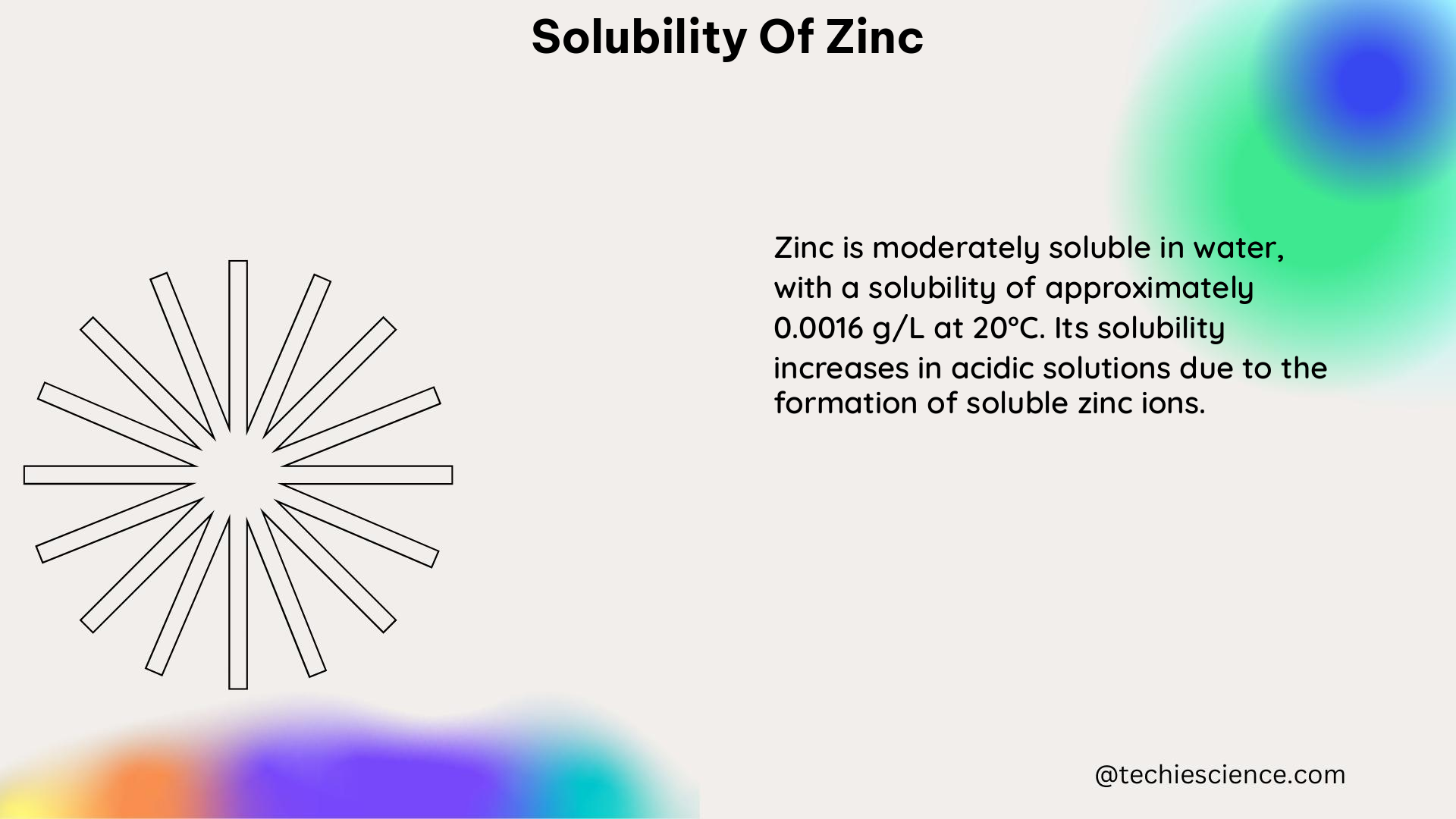The solubility of zinc in water is a crucial parameter in various scientific and industrial applications, ranging from water treatment to metallurgy. Understanding the factors that influence the solubility of zinc is essential for optimizing processes, predicting chemical behavior, and ensuring environmental sustainability.
Understanding the Solubility of Zinc
The solubility of zinc in water is typically reported to be around 2-8 × 10^-5 mol/L at 298.15 K (25°C). This value can vary depending on the specific form of zinc and the presence of other ions or molecules in the solution.
Factors Affecting Zinc Solubility
-
Zinc Speciation: The solubility of zinc can be influenced by the specific form or species of zinc present in the solution. For example, the solubility of zinc oxide is reported to be around 1 × 10^-5 mol/L at 298.15 K, while the solubility of zinc hydroxide is somewhat higher, with an order of magnitude of 1 × 10^-5 mol/L at the same temperature.
-
pH: The pH of the solution can significantly affect the solubility of zinc. Zinc is amphoteric, meaning it can act as both an acid and a base, and its solubility is typically higher in both acidic and basic environments.
-
Complexation: The presence of chelating agents or complexing agents can increase the solubility of zinc by forming soluble complexes with the zinc ions. This can be particularly important in natural water systems or industrial processes where various ligands may be present.
-
Temperature: The solubility of zinc can also be influenced by temperature. As the temperature increases, the solubility of zinc generally increases due to the increased kinetic energy of the system.
-
Ionic Strength: The presence of other ions in the solution can affect the solubility of zinc through ionic interactions and changes in the activity coefficients of the species involved.
Expressing Zinc Solubility
In addition to the molar concentration, the solubility of zinc can also be expressed in terms of its solubility product (Ksp), which is a measure of the equilibrium constant for the dissolution of a solid compound in water. For example, the Ksp for zinc oxide is reported to be 6 × 10^-4, while the Ksp for zinc hydroxide is 1 × 10^-2.
The Ksp value can be used to calculate the solubility of zinc in various solutions and to predict the precipitation or dissolution of zinc-containing compounds.
Zinc Solubility in Aqueous Solutions

The solubility of zinc in aqueous solutions can be influenced by the presence of other ions and molecules. Here are some examples:
Zinc Solubility in Electrolyte Solutions
The solubility of zinc can be affected by the presence of other electrolytes in the solution. For instance, the solubility of zinc in aqueous sodium chloride (NaCl) solutions has been studied extensively. The solubility of zinc increases with increasing NaCl concentration due to the formation of soluble zinc-chloro complexes.
Zinc Solubility in Acidic and Basic Solutions
As mentioned earlier, zinc is amphoteric, and its solubility is typically higher in both acidic and basic environments. In acidic solutions, the solubility of zinc increases due to the formation of soluble zinc cations (Zn^2+). In basic solutions, the solubility of zinc increases due to the formation of soluble zinc hydroxo complexes, such as [Zn(OH)4]^2-.
Zinc Solubility in the Presence of Chelating Agents
Chelating agents, such as EDTA (ethylenediaminetetraacetic acid) and citrate, can significantly increase the solubility of zinc by forming stable, soluble complexes. This is particularly important in various industrial and environmental applications, where the presence of chelating agents can enhance the mobility and bioavailability of zinc.
Zinc Solubility and Bioavailability
The solubility of zinc is not only important in industrial and environmental contexts but also plays a crucial role in biological systems. The bioavailability of zinc, which is the fraction of zinc that can be absorbed and utilized by living organisms, is directly related to its solubility.
Zinc Solubility and Absorption
The solubility of zinc in the gastrointestinal tract is a key factor in determining its absorption and bioavailability. Factors such as pH, the presence of other nutrients, and the presence of inhibitors or enhancers can all influence the solubility and subsequent absorption of zinc.
Zinc Solubility and Toxicity
While zinc is an essential trace element, excessive levels of soluble zinc can lead to toxicity. Understanding the factors that affect zinc solubility is crucial for maintaining a balance between adequate zinc intake and avoiding potential health risks.
Conclusion
The solubility of zinc is a complex and multifaceted topic that has significant implications in various scientific and industrial fields. By understanding the factors that influence zinc solubility, researchers and practitioners can optimize processes, predict chemical behavior, and ensure the sustainable use of this important element.
References
- The Solubility of Some Sparingly Soluble Salts of Zinc and Cadmium in Water and in Aqueous Electrolyte Solutions, NIST JPCRD 38(5), 2009.
- The Solubility of Some Sparingly Soluble Salts of Zinc and Cadmium, NIST JPCRD 444, 2012.
- The Molecular Basis for Zinc Bioavailability, PMC 10095312, 2020.
- Solubility of Zinc in Water: https://www.nist.gov/system/files/documents/srd/jpcrd38.pdf
- Solubility of Zinc in Aqueous Electrolyte Solutions: https://www.nist.gov/system/files/documents/srd/jpcrd444.pdf
- Molecular Basis for Zinc Bioavailability: https://www.ncbi.nlm.nih.gov/pmc/articles/PMC10095312/

The lambdageeks.com Core SME Team is a group of experienced subject matter experts from diverse scientific and technical fields including Physics, Chemistry, Technology,Electronics & Electrical Engineering, Automotive, Mechanical Engineering. Our team collaborates to create high-quality, well-researched articles on a wide range of science and technology topics for the lambdageeks.com website.
All Our Senior SME are having more than 7 Years of experience in the respective fields . They are either Working Industry Professionals or assocaited With different Universities. Refer Our Authors Page to get to know About our Core SMEs.